How does it feel to get lost among the narrow alleys and hidden squares of Genoa’s historical center? It’s one of the most original and captivating experiences you can have in a city that, within the picturesque maze of the “caruggi,” reveals its most authentic and unmissable side.
The streets and noble palaces tell ancient and surprising stories, waiting to be uncovered by strolling calmly through the medieval historic center, one of the largest in Europe: a unique place, full of hidden details and curiosities to discover.
A journey where the past slowly comes to life, amid imposing architecture and characteristic views: let yourself be carried away by Genoa’s magical spirit, surrounded by ever-new emotions that accompany every itinerary in the heart of La Superba.

Secret Genoa: a slow journey through the heart of its historical center
🥇 Visit Italy’s brand partnership
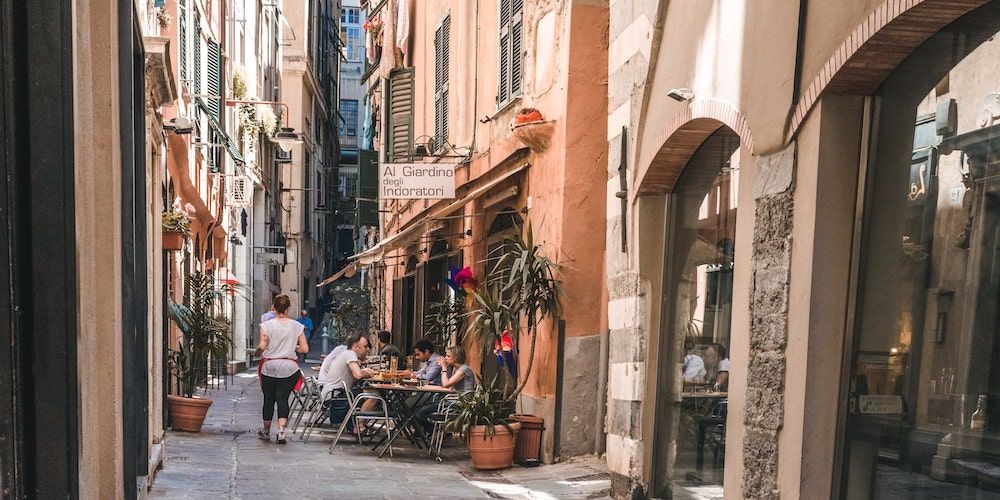
Genoa's historical center - photo Carolina Fanni
It’s one of the largest medieval historic centers in Europe – and one of the most fascinating. A picturesque maze of narrow alleys – the famous caruggi – that suddenly open onto historic squares, grand palaces, ancient churches and centuries-old shops.
If you want to discover the secrets of this outstanding city, let yourself be guided by the slow rhythm of its characteristic streets, with typical artisan workshops and focaccerie that have preserved ancient recipes and traditions for centuries.
The starting point is Piazza De Ferrari, the beating heart of the city, dominated by the majestic Palazzo Ducale. From here, you can reach the Cathedral of San Lorenzo and, continuing on foot, venture into the caruggi until you arrive at the Old Port, symbol of Genoa’s bond with the sea.
Then head towards the splendid Via Garibaldi, with its magnificent noble palaces, walk through the luxury shopping streets between Via Roma and Via XXV Aprile, and lose yourself among the hidden squares and the medieval alleys.
This is a route to dedicate an entire day to, because only by walking without hurry, guided by curiosity and the call of every hidden corner, will you be able to connect with the deep soul of Genoa’s historical center, uncovering the stories and traditions of an extraordinary city.
Discover unmissable places and experiences in GenoaListen to the podcast version of the article with the voice of Monna Lisa & Leonardo
Stage 1. Piazza De Ferrari: the core of Genoa’s historical center
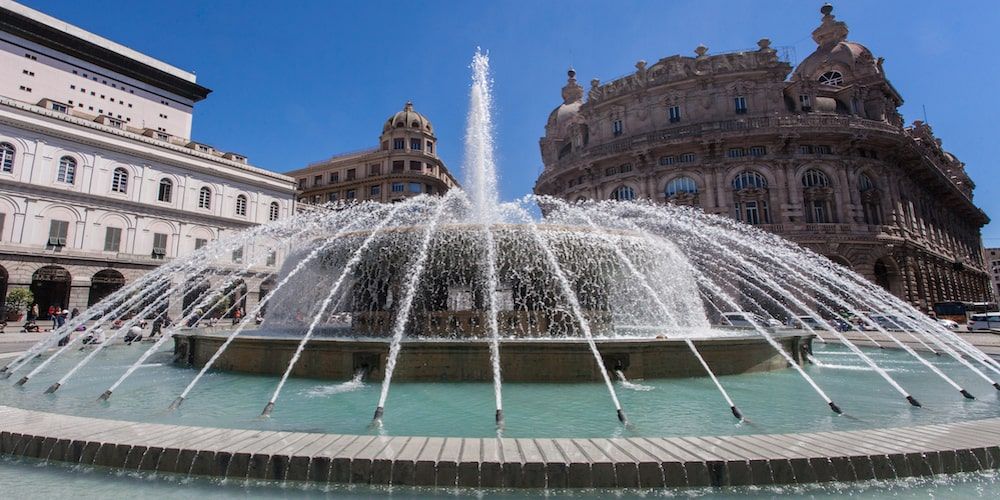
Piazza De Ferrari, photo by Alessandro Falcone
To uncover the secrets of Genoa’s historical center, there’s no better place to start than its beating heart. That’s why the elegant and majestic Piazza De Ferrari is the perfect starting point—a special place where the energies of an ancient and modern metropolis converge.
The square, named after Raffaele De Ferrari, Duke of Galliera, a figure who in the 19th century contributed to the expansion of the port, is easily recognizable by the beautiful bronze fountain that dominates the scene, a living symbol of the city’s vitality.
On its sides, you can admire a series of historic and fascinating buildings, such as Carlo Felice Theatre, Accademia Lingustica di Belle Arti, and Palazzo della Nuova Borsa, a true masterpiece of the Liberty style.
Directly opposite Palazzo della Borsa stands Palazzo Ducale, once the residence of the doges and today an important cultural and artistic center, home to international-level exhibitions and prestigious cultural events. From Piazza De Ferrari, you can only see part of Palazzo Ducale, while its main façade, with its grand staircase and imposing columns, is visible from the adjacent Piazza Matteotti.
The monumental halls of the Palazzo Ducale (the Hall of the Great Council, the Doge’s Apartment, and the stunning Chapel) house frescoes, memories, and stories of power that have shaped the life of the Republic of Genoa over the centuries. They are open to the public during exhibitions or when hosting events such as conferences and presentations—it’s definitely worth stepping inside!
Stage 2. San Lorenzo: the secrets of Genoa’s Cathedral
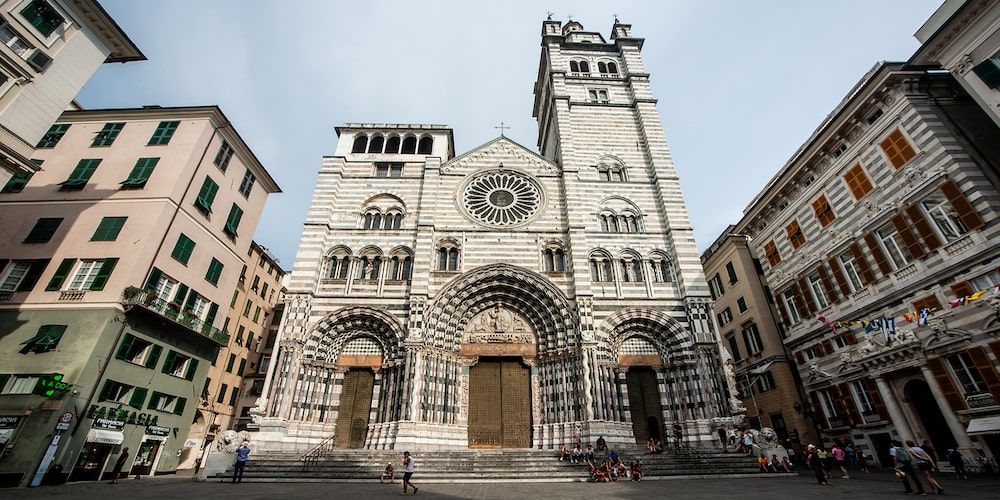
S.Lorenzo Cathedral - photo Liguria Digitale
Leave Piazza Matteotti, follow Via San Lorenzo, and reach the square of the same name, where the imposing silhouette of the Basilica di San Lorenzo dominates the scene. As Genoa’s Cathedral, symbol of the city, and one of the most enchanting churches in all of Italy, it dates back at least to the 9th century, though its current form is the result of transformations between the 12th and 14th centuries, during the maritime republic’s golden age.
The elegant white-and-black marble façade is a stunning example of Ligurian Gothic. Upon entering, you’ll find yourself immersed in centuries of history and art, from Romanesque remnants to Gothic naves and later Renaissance and Baroque transformations.
In the Chapel of St. John the Baptist lie the relics of Genoa’s patron Saint, while in the Museo del Tesoro you can admire liturgical objects and extraordinary artifacts, such as the Sacro Catino—a mysterious hexagonal green glass dish brought to Genoa by the Crusaders in the early 12th century, along with the ashes of the Baptist. Legend identifies it as the dish used by Jesus at the Last Supper.
Modern analysis has shown that the Catino is actually late ancient Roman glass, dating between the 1st and 2nd centuries AD. Even so, its historical and symbolic value remains immense: it’s an object that combines history, faith, and myth, and it continues to inspire an aura of mystery that captivates visitors and scholars alike.
Stop 3. The Caruggi: Genoa’s living labyrinth
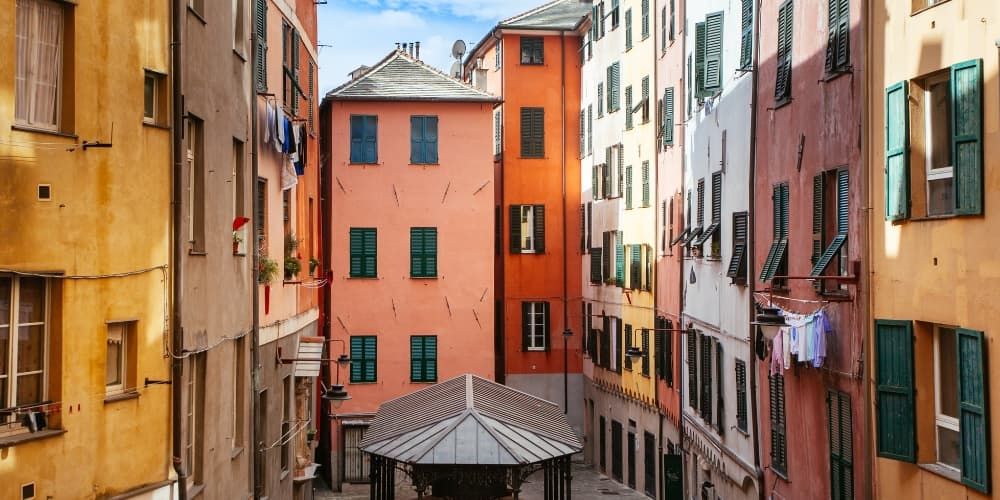
Truogoli di Santa Brigida, photo by Alessandro Falcone
From the Cathedral, simply head along Via di Scurreria to enter the oldest and most picturesque part of Genoa’s historical center, where the caruggi—narrow, winding alleys that define the city—unfold like a labyrinth of history, sounds, and scents.
Step by step, this maze of streets reveals unexpected and enchanting views: a bell tower rising above the rooftops, a carved stone doorway, a secluded little square. Between façades weathered by time, historic shops stand as if untouched by the centuries—silent guardians of crafts and flavors that speak of Genoa’s most authentic soul.
There’s no fixed route to follow, as wandering without a set destination captures the true essence of the caruggi. For example, you might pass through the small yet charming Piazza San Matteo and admire the namesake 12th-century Church and Cloister. Alternatively, head to Piazza delle Vigne, where you’ll find a modest church richly adorned inside with enchanting Baroque decorations.
Then, as you make your way toward the port area following the street signs along the road, stop in one of the lively squares filled with historic bars and cafés, and finally reach Piazza Banchi, where the Church of San Pietro in Banchi rises above: a unique example of blending the sacred and the profane, with the place of worship built atop shops and workshops!
Stage 4. Arcades, palaces, and the sea: Piazza Caricamento and the Old Port
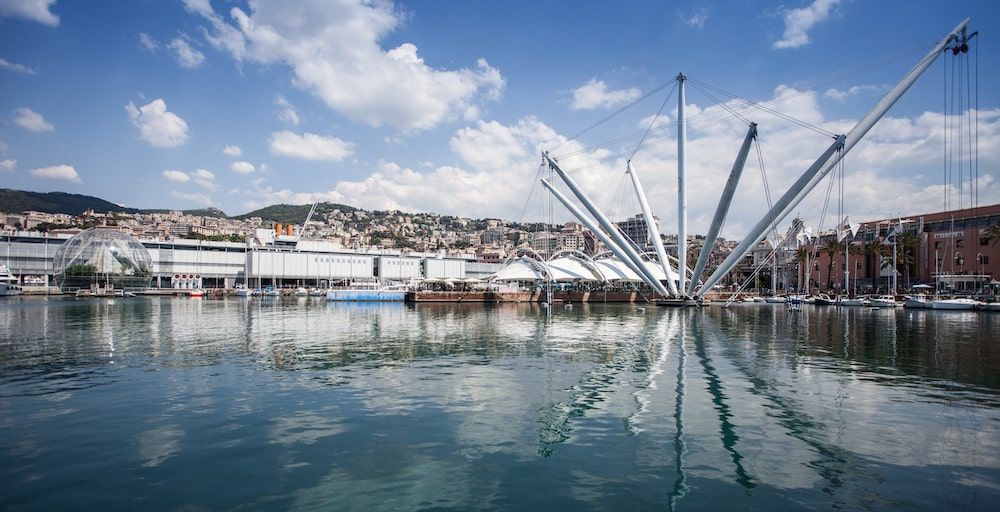
Genoa's historical center: Bigo, Old Port - photo Alessandro Falcone
Heading toward the sea, the majestic Piazza Caricamento comes into view, once the heart of Genoese commerce. Today, you can admire the elegant facades of historic buildings and the fabulous Sottoripa arcades, dating back to the 12th century and among the oldest in Italy, which overlook the square and keep alive the atmosphere of a place that has thrived on the sea for centuries.
Opposite stands the magnificent Palazzo San Giorgio, with the section that recreates its medieval appearance facing the Sottoripa arcade, and the late-Renaissance reconstruction overlooking the sea. Extraordinary for both its history and architecture, it lets you explore centuries of Genoese life between the Middle Ages and the Renaissance.
Piazza Caricamento serves as the gateway to the Old Port: a short walk away, you can ride the Bigo, Renzo Piano’s panoramic lift, to enjoy a view that embraces the entire area and its many attractions, such as the Aquarium, one of the most important in Europe, and the Galata Museo del Mare, which offers an engaging journey through Genoa’s maritime history.
In the distance, the Lanterna towers over the port, recalling the city’s millennial connection with the sea and providing an unforgettable photographic view.
Stage 5. Via Garibaldi: The Golden Street of the Rolli Palaces
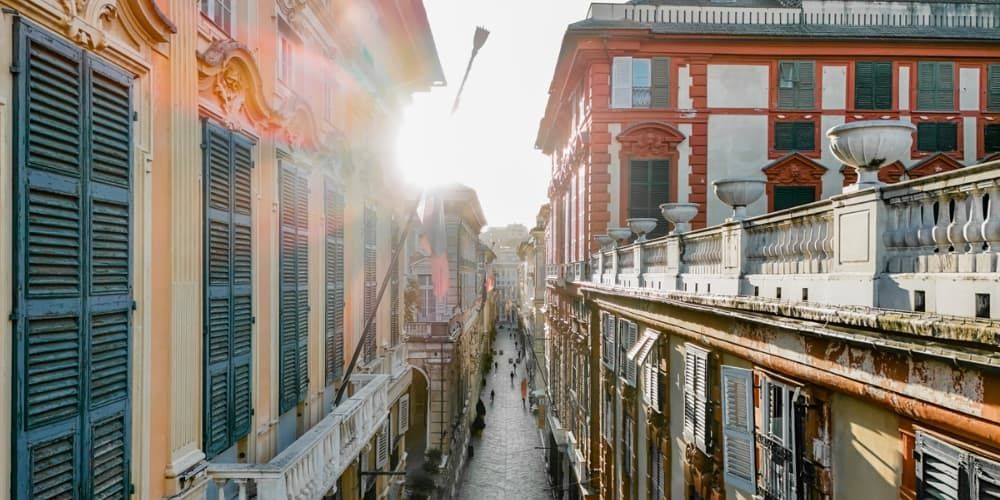
The Rolli Palaces are one of the best-kept secrets in Genoa’s historical center. Their name comes from the “rolli,” the official lists of the Republic where the city’s most prestigious private residences were registered—homes selected to host visiting ambassadors, princes, and dignitaries.
Over 100 palaces across the city were once part of this extraordinary network of hospitality. Today, 42 are protected as UNESCO World Heritage Sites: their frescoed halls, sunlit courtyards, and refined façades still radiate a wonderful atmosphere untouched by time.
From the Old Port, it takes only a few minutes to reach the historic Strada Nuova —now Via Garibaldi— where you’ll encounter treasures such as Palazzo Bianco, with its remarkable collections of Italian and Flemish art; Palazzo Rosso, instantly recognizable by its deep crimson façade and its richly frescoed interiors; and Palazzo Tursi, home to the City Hall and custodian of Paganini’s legendary “Cannone” violin.
A total of 12 Rolli Palaces stand proudly along Via Garibaldi. All you have to do is look up and take your time, letting this open-air museum draw you into the authentic charm of Genoa’s golden age.
Stage 6. From Porta Soprana to the cloisters of the Museo di Sant’Agostino
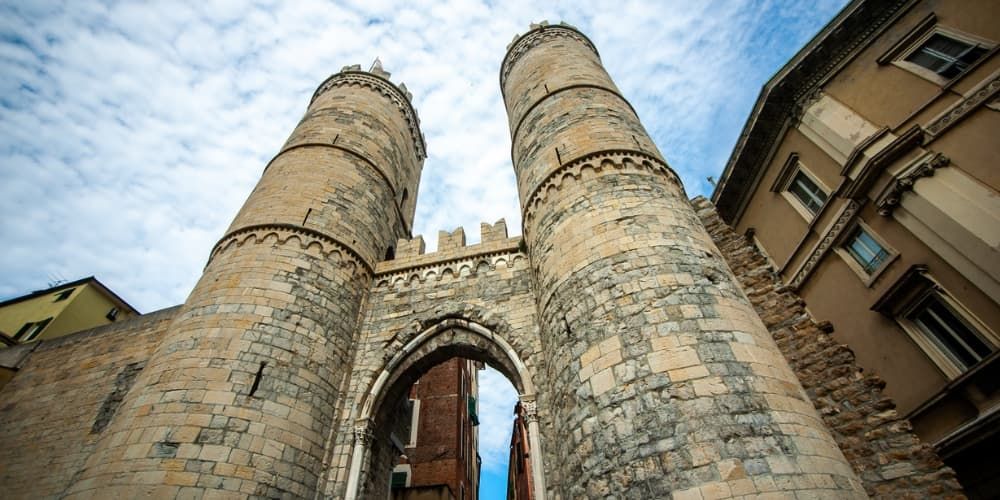
Porta Soprana, photo by Liguria Digitale
At the end of Via Garibaldi, you’ll find yourself in Piazza delle Fontane Marose, a refined urban salon that likely takes its name from the ancient fountain that once stood there. Today, the square is still adorned with prestigious Rolli Palaces, such as Palazzo Paolo and Nicolò Interiano, Palazzo Agostino Ayrolo, and Palazzo Giacomo Spinola.
From here, turning onto Via XXV Aprile and walking past the Teatro Carlo Felice, you will find yourself in Piazza De Ferrari, the starting and ending point of your journey through Genoa’s historical center.
But the adventure isn’t over yet: beyond the square, you’ll step into another part of the city’s medieval core. You can choose to enter through the magnificent Porta Soprana, one of the city’s ancient gateways, just a few steps away from Piazza De Ferrari.
Take your time to admire the two imposing twin stone towers, built in the 12th century, which still today evoke the power and allure of the Maritime Republic, marking the most iconic entrance to the historic center. Then, leave Porta Soprana behind and walk about 200 meters along Via di Ravecca until you reach Piazza Sarzano, home to the Museo di Sant’Agostino, housed in a 13th-century convent.
While awaiting the restoration work that will once again reveal its quiet cloisters and Gothic vaults, you can admire major masterpieces of medieval sculpture displayed in the breathtaking interior of the Church of Sant’Agostino, the largest Gothic church in Genoa.
Stage 7. The medieval soul of Genoa
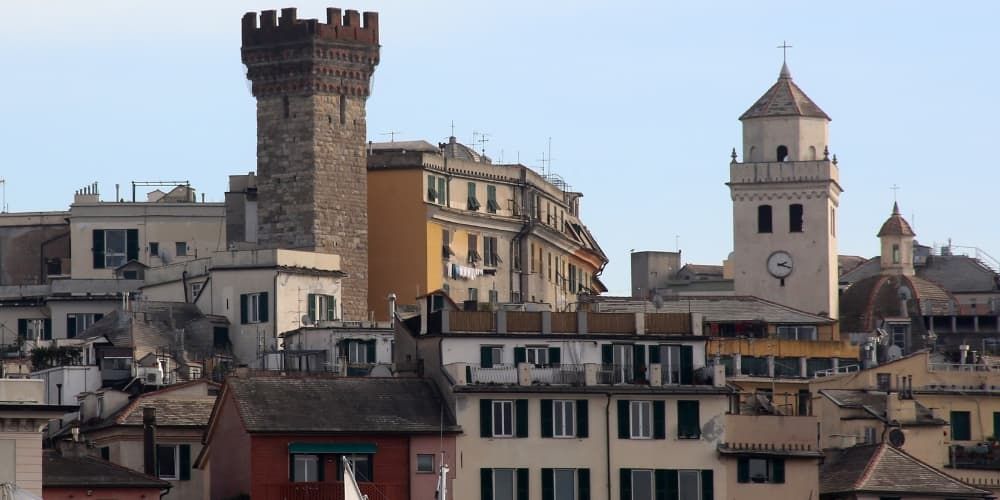
Torre degli Embriaci, photo by F.Bussalino
From Piazza Sarzano, continue along Via Santa Maria di Castello to reach the base of the so-called Torre degli Embriaci, one of the few surviving towers from medieval Genoa and a symbol of the power and wealth of the noble families who once ruled the city.
Standing approximately 41 meters tall, equivalent to 165 Genoese palms – the old local unit of measurement, just under 25 centimeters – the Torre degli Embriaci far exceeded the limit set by the 1196 edict, which required all city towers to be reduced to 80 palms, about 20 meters. Despite the restriction, the tower was spared, likely as a mark of respect for Guglielmo Embriaco, the Genoese commander celebrated for his role in the First Crusade.
Around the Torre degli Embriaci, a maze of alleys opens into a sequence of charming little squares — San Cosimo, Barisione, Cattaneo, San Giorgio, Stella, and della Stampa — secluded, picturesque corners that preserve an authentic atmosphere.
From Piazza della Stampa, turning left onto Via di Canneto il Lungo, the route leads you back to Piazza De Ferrari, completing this enchanting journey that blends famous landmarks with hidden gems, revealing the full complexity and genuine charm of Genoa’s historic center.
Bonus stage. The historic shops
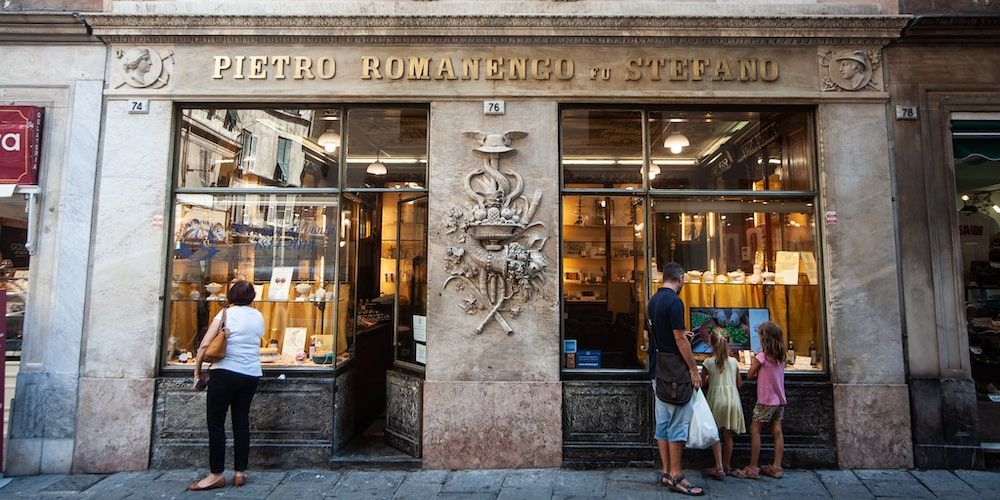
Genoa's historical Center: Romanengo historic shop - photo Liguria Digitale
After exploring squares, churches, and palaces, your itinerary through the heart of La Superba wouldn’t be complete without a special bonus: a stop at the historic shops, where tradition and flavors reveal the true soul of Genoa.
These shops are a living heritage. Confectioneries, chocolatiers, pastry shops, cafés, fabric stores, artisan workshops, grocery stores, and traditional fry shops—places that have been cherished for centuries by poets, musicians, and intellectuals, such as the legendary Genoese singer-songwriter Fabrizio De André and the actor, comedian, and writer Paolo Villaggio.
Amid original furnishings and atmospheres from another era, you can enjoy sugared almonds, candied fruit, artisanal chocolates, the traditional pandolce and savory specialties such as farinata and panissa. Some shops, like Cantine Moretti and the Antica Friggitoria Carega, preserve 19th- and 20th-century interiors, with such authentic charm that they have even been used as film sets.
FAQs: everything you need to know to Explore Genoa’s historical center
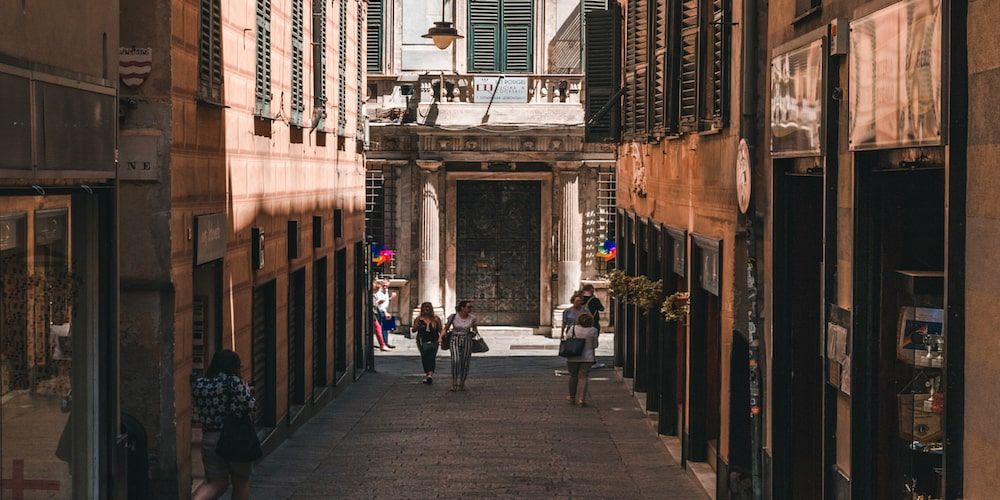
Genoa's historical center - image by Carolina Fanni
1. Where is the historical center in Genoa?
The historical center is in the heart of Genoa, stretching from Piazza De Ferrari to the Old Port area, and is one of the largest medieval city centers in Europe.
2. How do I get to Genoa’s historical center by public transport?
You can reach it by bus, metro, or train. Genova Brignole and Genova Piazza Principe are the main train stations, and several bus lines and the metro stop close to key attractions.
3. What are the must-see attractions in Genoa’s historical center?
Key sights include Via Garibaldi with its palaces, Piazza De Ferrari, the Cathedral of San Lorenzo, the Old Port, and the historic shops for a taste of local tradition.
4. Where can I try traditional Genoese food in the historical center?
You can sample specialties in historic shops, bakeries, friggitorie, and local trattorie. Don’t miss focaccia, farinata, pesto dishes, and artisan sweets!
5. Is one day in Genoa's historical center enough?
One day is enough for an overview of main sights, but more time allows you to explore streets, hidden corners, and enjoy full local experience.
About the author
Written on 02/10/2025


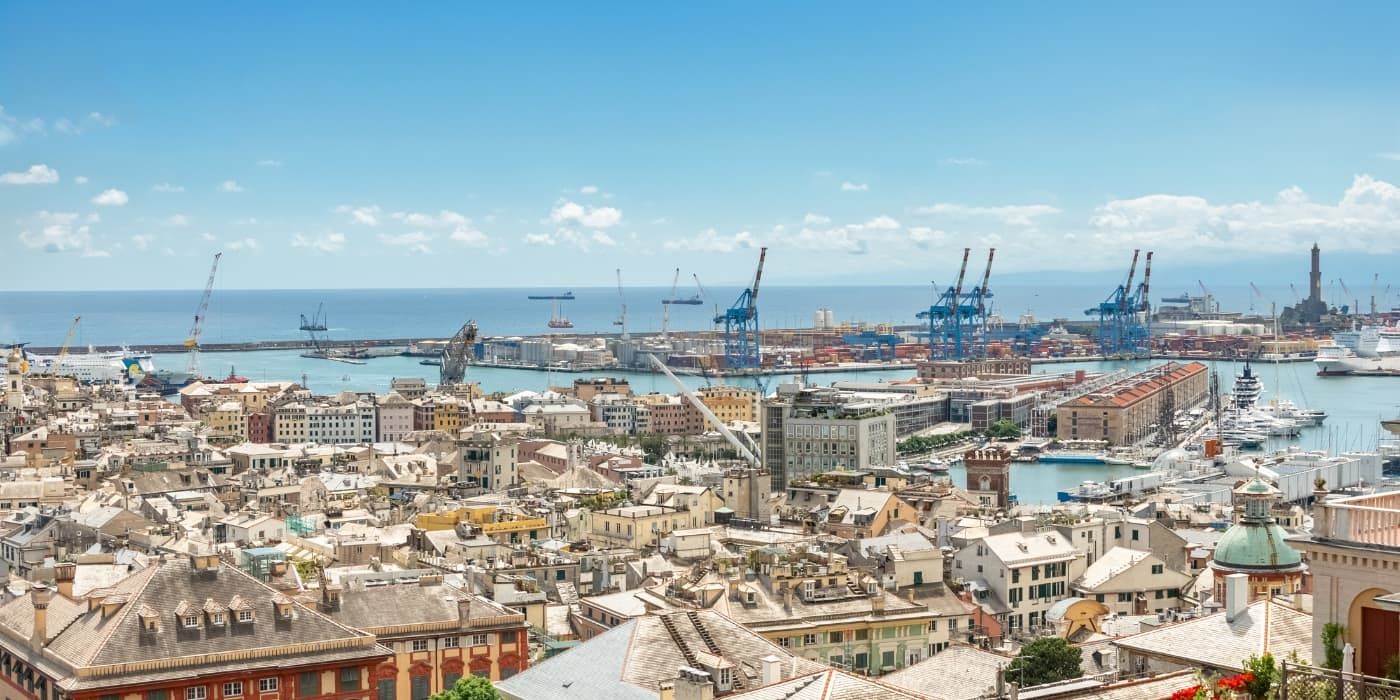

Alessandro Savino
Experience the timeless charm of Genoa’s historical center: an itinerary through splendid noble palaces, ancient alleyways, and authentic atmospheres.